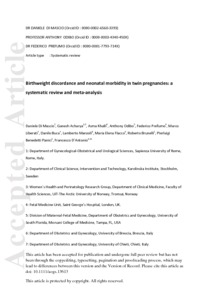Di Mascio, D;
Acharya, G;
Khalil, A;
Odibo, A;
Prefumo, F;
Liberati, M;
Buca, D;
Manzoli, L;
Flacco, ME;
Brunelli, R;
et al.
Di Mascio, D; Acharya, G; Khalil, A; Odibo, A; Prefumo, F; Liberati, M; Buca, D; Manzoli, L; Flacco, ME; Brunelli, R; Benedetti Panici, P; D'Antonio, F
(2019)
Birthweight discordance and neonatal morbidity in twin pregnancies: A systematic review and meta‐analysis.
Acta Obstet Gynecol Scand, 98 (10).
pp. 1245-1257.
ISSN 1600-0412
https://doi.org/10.1111/aogs.13613
SGUL Authors: Khalil, Asma
![[img]](https://openaccess.sgul.ac.uk/110816/1.hassmallThumbnailVersion/Mascio_et_al-2019-Acta_Obstetricia_et_Gynecologica_Scandinavica.pdf)  Preview |
|
PDF
Accepted Version
Available under License ["licenses_description_publisher" not defined].
Download (1MB)
| Preview
|
Abstract
Introduction
The aim of this systematic review was to quantify the association between birthweight discordance and neonatal morbidity in twin pregnancies.
Material and methods
MEDLINE, Embase and Cinahl databases were searched. Studies reporting the occurrence of morbidity in twins affected compared with those not affected by birthweight discordance were included. The primary outcome was composite neonatal morbidity (including neurological, respiratory, infectious morbidities, abnormal acid‐base status and necrotizing enterocolitis). The secondary outcomes were the individual morbidities. Sub‐group analysis according to chorionicity, gestational age at birth and fetal weight (smaller vs larger twin) was also performed. Random‐effect head‐to‐head meta‐analyses were used to analyze the data.
Results
Twenty studies (10 851 twin pregnancies) were included. The risk of composite morbidity was significantly higher in the pregnancies with birthweight discordance ≥15% (odds ratio [OR] 1.4, 95% confidence interval [CI] 1.0‐1.9), ≥20% (OR 2.2, 95% CI 1.40‐3.45), ≥25% (OR 2.5, 95% CI 1.8‐3.6), and ≥30% (OR 3.4, 95% CI 2.2‐3.2). In dichorionic twins, birthweight discordance ≥15% (OR 2.4, 95% CI 1.65‐3.46), ≥20% (OR 2.2, 95% CI 1.3‐3.8), ≥25% (OR 2.7, 95% CI 1.4‐5.1) and ≥30% (OR 3.6, 95% CI 2.3‐5.7) were all significantly associated with composite neonatal morbidity. Analysis of monochorionic twins was hampered by the very small number of included studies, which precluded adequate statistical power. Monochorionic twins with a birthweight discordance ≥20% were at significantly higher risk of composite neonatal morbidity (OR 2.2, 95% CI 1.1‐4.9) compared with those presenting with lesser degree of discordance. When stratifying the analysis according to gestational age at birth and fetal size, twins with birthweight discordance ≥15%, 20%, 25% and 30% delivered at ≥34 weeks were at higher risk of neonatal morbidity compared with controls, but there was no difference in the risk of morbidity between the larger and the smaller twin in the discordant pair.
Conclusions
Birthweight discordance is associated with neonatal morbidity in twin pregnancies. The strength of this association persists for dichorionic twins. It was not possible to extrapolate robust evidence on monochorionic twins due to the low power of the analysis due to the small number of included studies.
| Item Type: |
Article
|
| Additional Information: |
This is the peer reviewed version of the following article: Di Mascio, D, Acharya, G, Khalil, A, et al. Birthweight discordance and neonatal morbidity in twin pregnancies: A systematic review and meta‐analysis. Acta Obstet Gynecol Scand. 2019; 98: 1245‐ 1257, which has been published in final form at https://doi.org/10.1111/aogs.13613. This article may be used for non-commercial purposes in accordance with Wiley Terms and Conditions for Use of Self-Archived Versions. |
| Keywords: |
birthweight discordance, dichorionic twins, monochorionic twins, neonatal morbidity, twin pregnancies, ultrasound, 1114 Paediatrics And Reproductive Medicine, 1117 Public Health And Health Services, Obstetrics & Reproductive Medicine |
| SGUL Research Institute / Research Centre: |
Academic Structure > Molecular and Clinical Sciences Research Institute (MCS) |
| Journal or Publication Title: |
Acta Obstet Gynecol Scand |
| ISSN: |
1600-0412 |
| Language: |
eng |
| Dates: |
| Date | Event |
|---|
| 20 September 2019 | Published | | 23 May 2019 | Published Online | | 18 March 2019 | Accepted |
|
| Publisher License: |
Publisher's own licence |
| PubMed ID: |
30903624 |
 |
Go to PubMed abstract |
| URI: |
https://openaccess.sgul.ac.uk/id/eprint/110816 |
| Publisher's version: |
https://doi.org/10.1111/aogs.13613 |
Statistics
Item downloaded times since 17 Apr 2019.
Actions (login required)
 |
Edit Item |



